The Future of Television: How Virtual Production Studios Are Changing TV Production
The television industry is transforming significantly, driven by technological advancements that enhance creativity, efficiency, and viewer engagement. One of the most groundbreaking innovations in this space is the emergence of virtual production studio. By combining real-time rendering technologies with traditional filmmaking techniques, these studios are reshaping how content is produced and delivered. This article explores the impact of virtual production studios on television production and their potential for the future.
What is a Virtual Production Studio?
A virtual production studio integrates digital and physical elements, allowing filmmakers to create immersive environments that blend reality with virtual graphics. Unlike traditional studios relying solely on green screens, virtual production uses LED screens, motion capture, and sophisticated software to generate real-time dynamic backgrounds. This approach enables actors to perform within their environment rather than in front of a blank screen, enhancing their performance and the overall production quality.
Key Features of Virtual Production
- Real-Time Rendering: Virtual production studios utilize advanced rendering engines to create high-quality graphics that respond instantaneously to the actors’ movements and camera angles. This real-time feedback allows for immediate adjustments, making the filming process more efficient.
- Enhanced Collaboration: These studios facilitate seamless collaboration among departments, including cinematography, art direction, and visual effects. As a result, directors and producers can make informed decisions during filming, reducing the need for extensive post-production edits.
- Immersive Environments: Virtual production studios can replicate any setting, from a bustling city to an alien landscape, using large LED screens. This capability saves on location costs and reduces the logistical challenges associated with traditional filming.
The Impact on Television Production
Increased Efficiency
Integrating virtual production into television production has led to significant efficiency gains. Production schedules can be tightened by allowing creators to visualize complex scenes in real-time, reducing overall costs. For instance, the use of virtual sets means fewer location shoots, which can often be time-consuming and expensive. A media production agency can streamline these processes, ensuring that projects are delivered on time and within budget.
Improved Visual Quality
As audience expectations rise, so does the demand for high-quality visual content. Virtual production enables creators to achieve cinematic-quality visuals in television programming. The combination of real-time rendering and advanced camera tracking creates stunning imagery that captivates viewers. Shows like “The Mandalorian” have showcased the potential of virtual production, setting new standards for visual storytelling in television.
Creative Freedom
Virtual production opens up a realm of creative possibilities for filmmakers. The ability to manipulate virtual environments in real time allows for innovative storytelling techniques that were previously challenging to implement. Directors can experiment with various visual elements without the constraints of physical sets, enabling them to push the boundaries of traditional television narratives.
Challenges and Considerations
While the benefits of virtual production are clear, there are challenges to consider. The technology requires substantial investment in equipment and training. Additionally, creators must adapt to new workflows that may differ significantly from traditional production methods. However, as the technology becomes more accessible and affordable, these challenges will likely diminish.
Training and Skill Development
As virtual production studios gain traction, the demand for skilled professionals is increasing. Media production agencies are now prioritizing training programs to equip their teams with the necessary skills to operate within these advanced environments. This focus on education will ensure that the industry continues to evolve and embrace the future of television production.
The Road Ahead
As we look to the future, the impact of virtual production studios on television production will only grow. With ongoing technological advancements, such as artificial intelligence and machine learning, the potential for immersive storytelling is limitless. Creators will be able to develop richer narratives, engage audiences in new ways, and redefine what television can be.
Conclusion
Virtual production studios represent a significant shift in television production, offering a unique blend of technology and creativity. As these studios continue to innovate and expand, they will play a pivotal role in shaping the future of television. By enhancing efficiency, improving visual quality, and providing creative freedom, virtual production is poised to become a standard practice in the industry, ensuring that the television landscape remains dynamic and engaging for audiences worldwide.














Post Comment